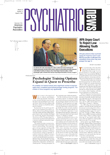A 13th APA practice guideline, Practice Guideline for the Treatment of Patients With Acute Stress Disorder and Posttraumatic Stress Disorder, is ready to make its debut. It was approved by APA's Board of Trustees in June.
The guideline is built from the “best evidence-based and clinical-practice knowledge that one could ever imagine assembling,” Robert Ursano, M.D., chair of the Work Group on ASD and PTSD, told Psychiatric News.
“With the present concerns of the nation for terrorism and the need for all clinicians to be able to help those who experience the ravages of a motor vehicle accident, a rape, or a war, the guideline can assure practitioners that they are using the best possible treatments for their patients.”
The practice guideline is divided into three parts: practical guidance and recommendations regarding the assessment and treatment of acute stress disorder and posttraumatic stress disorder; review and synthesis of the research literature from which the recommendations are derived; and future research needs.
Since the document is meant to be taken as a whole, digesting the entire guideline is the recommended course of action, David Benedek, M.D., consultant to the Work Group on ASD and PTSD, said in an interview. But undoubtedly the first part of the guideline—treatment recommendations—will be of greatest interest to most psychiatrists, he added.
Actual work on the practice guideline started in 2002, but planning for the guideline predated that, Robert Kunkle, senior program manager for APA practice guidelines, told Psychiatric News. In fact, he added,“ It might be safe to say that after 9/11, there was increased awareness of acute stress disorder and posttraumatic stress disorder and a need for some guidelines on treatment. So it probably wouldn't be inaccurate to say that that was an important factor leading to [the formation of] the work group” that developed the guideline.
The members of the work group “represented a wide range of knowledge and skills and were dedicated to both educating our APA members and helping those exposed to traumatic events,” Ursano said.
Benedek noted, “The work group did the lion's share of the work in reviewing hundreds of articles and research on posttraumatic stress disorder and acute stress disorder and putting together the initial draft.” The work group also got widespread input, for example, from the Steering Committee on Practice Guidelines, numerous consultants and liaisons, the APA Assembly, and APA staff.
One of the biggest challenges in developing the guideline, Benedek said, was that research data continued “to come out after the initial work and reviewing.” Another problem was dealing with holes in the research. In these cases, the work group “had to try to come up with an appropriate balance of recommendations based on what research was available and that which was the result of political consensus and expert opinion.
Four other APA practice guidelines are now being worked on, Kunkle reported. They are a new guideline on obsessive-compulsive disorder and revised guidelines on psychiatric evaluation, Alzheimer's disease and other dementias of late life, and eating disorders. “We're investigating doing a guideline on aggressive behaviors,” he added. “That depends on the evidence available.”
Part A of the ASD and PTSD practice guideline, that is, the treatment recommendations, will be published as a supplement to the NovemberAmerican Journal of Psychiatry.The entire practice guideline will also become available at that time on APA's Web site at<www.psych.org/psych_pract/treatg/pg/prac_guide.cfm>.▪
